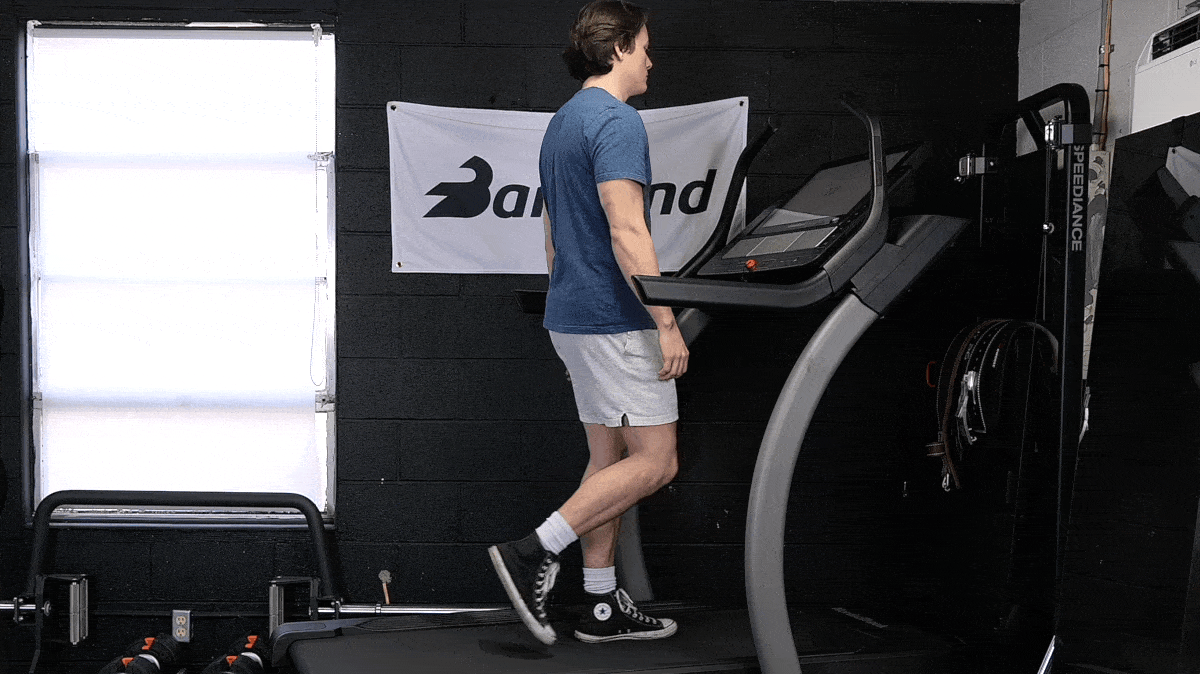Muscle Insider
New member
Cardio is a bit like eating your vegetables. You know you should, but that doesn’t make it fun to do. We’re sympathetic, but we also know that building stamina for your cardio workouts is essential — particularly if you’re working on your running game. Increasing your running stamina isn’t quite as simple as “run more,” but it almost...
The post How To Build Stamina for Running: 6 Tips + Benefits appeared first on BarBend.
Cardio is a bit like eating your vegetables. You know you should, but that doesn’t make it fun to do. We’re sympathetic, but we also know that building stamina for your cardio workouts is essential — particularly if you’re working on your running game.
Increasing your running stamina isn’t quite as simple as “run more,” but it almost is. If you’re looking to up your mileage on the track or treadmill, you’ve come to the right place. This handy guide will help you increase your fitness level on a run or jog, one step at a time. Grab your running shoes and let’s get going.

Editor’s Note: The content on BarBend is meant to be informative in nature, but it should not be taken as medical advice. When starting a new training regimen and/or diet, it is always a good idea to consult with a trusted medical professional. We are not a medical resource. The opinions and articles on this site are not intended for use as diagnosis, prevention, and/or treatment of health problems. They are not substitutes for consulting a qualified medical professional.
Why Stamina Matters
In order to appreciate why your cardiovascular system needs plenty of stamina, we need to establish working definitions for both stamina and endurance in the first place.
Stamina refers to your capacity to perform activity; both the physical exertion required and the mental or psychological impact of carrying out those tasks. Endurance refers specifically to the physiology behind exercise — cardiovascular endurance describes the ability of your heart to establish (and maintain) a certain level of output over time.
[Read More: How to Balance Running and Strength Training, No Matter Your Goals]
What do you need stamina for? More than running; squats, interval training, cross-training, cycling, and strength training all require varying levels of stamina. But if you build your cardiovascular stamina up with running, those gains should transfer across just about anything you do in the gym.
How To Measure (and Test) Your Stamina
Stamina and endurance are hard to quantify. The best distance runners in the world can cover hundreds of miles at a time, and there’s no single benchmark that delineates “good” endurance levels. That said, some common cardiovascular fitness tests that incorporate stamina include:
[Read More: How to Run a Faster Mile, According to a Running Coach]
According to the Mayo Clinic, (1) your speed over a 1.5-mile jog is also a good indicator of both your endurance and overall cardiovascular fitness levels. Individuals between the ages of 25 and 35 should be able to jog 1.5 miles in roughly 11 minutes (if male) and 13 or so minutes (if female).
6 Tips for Building Your Stamina
To build stamina properly, you need to perform more work over time. But let us stress one thing: There’s more to running endurance than merely going on longer runs, or running more frequently. Those are important aspects, yes, but they don’t paint a complete picture.
1. Start Slow and Easy
As with anything, you don’t want to dive headfirst into a full-fledged running workout plan that you aren’t accustomed to. If you have experience with distance running, sure, you can crank up your volume a good bit.
But if you’re an inexperienced runner, your best bet is to make incremental changes. Try increasing your run times by 5 or 10 minutes per session, or if you only run twice a week, consider adding a third active recovery workout into the mix.

[Read More: The Best Treadmills for Walking]
Also, don’t be afraid to boost your exercise volume by walking. Walking works all of the same muscles and trains your heart just like jogging does, but is less intense and reduces the impact on your joints.
2. More Frequency!
When it comes to running endurance, you can only go so long before emptying your gas tank. You can’t realistically run for 4 straight hours once a week, but you could probably crush several 90-minute running workouts, provided your recovery is on point.
Increasing the frequency of your running — while keeping a close eye on your overall fatigue levels — is a great way to improve your stamina without committing hours per day to a single workout.
3. Distract Yourself
As we’ve mentioned, stamina is both a physical and mental game. If you tend to fixate on how tired you feel, or how long the workout you’re doing feels, you’re probably sapping yourself of energy.
[Read More: Running on a Treadmill Vs. Running Outside — Which Is Best for Your Goals?]
As such, you might want to bring some form of distraction along with you on your running workouts if you’re trying to improve your stamina. You can listen to music, crush a podcast, or invite a friend along. Time flies when you’re having fun.
4. Do Your Prehab
Increasing your physical activity levels comes at a cost. This is true for both weight lifting and long-duration, steady-state cardio. Most people’s cardiovascular fitness levels improve faster than their soft tissue integrity; it takes time for your tendons and ligaments to adjust to higher volumes of running.
[Read More: Try This Dynamic Warm-Up for Running]
As such, when working on your stamina, take extra care to monitor how your body feels and perform appropriate prehab — stretching before and after your workouts, diligently following a warm-up routine, and making adjustments for aches and pains when necessary.
5. Don’t Forget Strength Training
Whether you’re a beginner or advanced runner, you should still try to implement some strength training if your goal is to improve your stamina. It may seem contradictory at first, but even small doses of weight lifting can do wonders for your posture, joint stability, and coordination.

[Read More: How Much Cardio Is Too Much? Running Coaches Weigh In]
While you’ll want to train your entire body with weights, you should emphasize lower-body exercises and workouts since, well, those are the muscles that perform the most work during a run. Stick to the basics here and try to perform some of the following movements at least once per week:
6. Do HIIT
When trying to bolster your stamina, the majority of your running workouts should be relatively low effort. However, mixing up your training works wonders, and too much specificity can actually be a bad thing.
[Read More: Expert Tested: The Best Treadmills for Running]
Don’t buy it? A 2015 meta analysis — meaning, a study examining the existing literature on a topic — on endurance training vs. high-intensity cardio found that, “Endurance training and HIT both elicit large improvements in the VO2max of healthy, young to middle-aged adults, with the gains in VO2max being greater following HIT when compared with endurance training.” (2)
Benefits of More Stamina
Stamina isn’t worth building up for its own sake. Sure, improving your cardio game will help you perform more cardio. But that’s just the tip of the iceberg, in our opinion.
FAQs
How do beginners build stamina for running?[/b] The best way to build up running stamina is to gradually run for longer durations. However, you don’t want to overtax yourself — focus on accumulating mileage across multiple low to moderate-intensity sessions.
What are the benefits of building stamina for running[/b] The more stamina you have, the longer you can tolerate a brisk jog or swift run. Stamina is to running as strength is to weight lifting — improving your stamina will allow you to run farther, longer, and at faster paces.
How does running affect your stamina?[/b] Running is one of the best ways to develop cardiovascular stamina. It’s a moderate intensity form of exercise that you can perform just about anywhere, and as often as daily if you want to beef up your endurance in a hurry.
References
[*]Mayo Foundation for Medical Education and Research. (2024, January 18). Measure your fitness level with these simple tests. Mayo Clinic.
[*]Milanovi? Z, Sporiš G, Weston M. Effectiveness of High-Intensity Interval Training (HIT) and Continuous Endurance Training for VO2max Improvements: A Systematic Review and Meta-Analysis of Controlled Trials. Sports Med. 2015 Oct;45(10):1469-81. doi: 10.1007/s40279-015-0365-0. PMID: 26243014.
The post How To Build Stamina for Running: 6 Tips + Benefits appeared first on BarBend.
Click here to view the article.
The post How To Build Stamina for Running: 6 Tips + Benefits appeared first on BarBend.
Cardio is a bit like eating your vegetables. You know you should, but that doesn’t make it fun to do. We’re sympathetic, but we also know that building stamina for your cardio workouts is essential — particularly if you’re working on your running game.
Increasing your running stamina isn’t quite as simple as “run more,” but it almost is. If you’re looking to up your mileage on the track or treadmill, you’ve come to the right place. This handy guide will help you increase your fitness level on a run or jog, one step at a time. Grab your running shoes and let’s get going.

Editor’s Note: The content on BarBend is meant to be informative in nature, but it should not be taken as medical advice. When starting a new training regimen and/or diet, it is always a good idea to consult with a trusted medical professional. We are not a medical resource. The opinions and articles on this site are not intended for use as diagnosis, prevention, and/or treatment of health problems. They are not substitutes for consulting a qualified medical professional.
Why Stamina Matters
In order to appreciate why your cardiovascular system needs plenty of stamina, we need to establish working definitions for both stamina and endurance in the first place.
Stamina refers to your capacity to perform activity; both the physical exertion required and the mental or psychological impact of carrying out those tasks. Endurance refers specifically to the physiology behind exercise — cardiovascular endurance describes the ability of your heart to establish (and maintain) a certain level of output over time.
[Read More: How to Balance Running and Strength Training, No Matter Your Goals]
What do you need stamina for? More than running; squats, interval training, cross-training, cycling, and strength training all require varying levels of stamina. But if you build your cardiovascular stamina up with running, those gains should transfer across just about anything you do in the gym.
How To Measure (and Test) Your Stamina
Stamina and endurance are hard to quantify. The best distance runners in the world can cover hundreds of miles at a time, and there’s no single benchmark that delineates “good” endurance levels. That said, some common cardiovascular fitness tests that incorporate stamina include:
- The Cooper Test: Cover as much distance as possible in 12 minutes. Input your stats into an online calculator to see how you rank.
- PACER Test: The Progressive Aerobic Cardiovascular Endurance Run test is a progressive shuttle run test that measures your endurance by gradually increasing the tempo of the exam.
[Read More: How to Run a Faster Mile, According to a Running Coach]
According to the Mayo Clinic, (1) your speed over a 1.5-mile jog is also a good indicator of both your endurance and overall cardiovascular fitness levels. Individuals between the ages of 25 and 35 should be able to jog 1.5 miles in roughly 11 minutes (if male) and 13 or so minutes (if female).
6 Tips for Building Your Stamina
To build stamina properly, you need to perform more work over time. But let us stress one thing: There’s more to running endurance than merely going on longer runs, or running more frequently. Those are important aspects, yes, but they don’t paint a complete picture.
1. Start Slow and Easy
As with anything, you don’t want to dive headfirst into a full-fledged running workout plan that you aren’t accustomed to. If you have experience with distance running, sure, you can crank up your volume a good bit.
But if you’re an inexperienced runner, your best bet is to make incremental changes. Try increasing your run times by 5 or 10 minutes per session, or if you only run twice a week, consider adding a third active recovery workout into the mix.

[Read More: The Best Treadmills for Walking]
Also, don’t be afraid to boost your exercise volume by walking. Walking works all of the same muscles and trains your heart just like jogging does, but is less intense and reduces the impact on your joints.
2. More Frequency!
When it comes to running endurance, you can only go so long before emptying your gas tank. You can’t realistically run for 4 straight hours once a week, but you could probably crush several 90-minute running workouts, provided your recovery is on point.
Increasing the frequency of your running — while keeping a close eye on your overall fatigue levels — is a great way to improve your stamina without committing hours per day to a single workout.
3. Distract Yourself
As we’ve mentioned, stamina is both a physical and mental game. If you tend to fixate on how tired you feel, or how long the workout you’re doing feels, you’re probably sapping yourself of energy.
[Read More: Running on a Treadmill Vs. Running Outside — Which Is Best for Your Goals?]
As such, you might want to bring some form of distraction along with you on your running workouts if you’re trying to improve your stamina. You can listen to music, crush a podcast, or invite a friend along. Time flies when you’re having fun.
4. Do Your Prehab
Increasing your physical activity levels comes at a cost. This is true for both weight lifting and long-duration, steady-state cardio. Most people’s cardiovascular fitness levels improve faster than their soft tissue integrity; it takes time for your tendons and ligaments to adjust to higher volumes of running.
[Read More: Try This Dynamic Warm-Up for Running]
As such, when working on your stamina, take extra care to monitor how your body feels and perform appropriate prehab — stretching before and after your workouts, diligently following a warm-up routine, and making adjustments for aches and pains when necessary.
5. Don’t Forget Strength Training
Whether you’re a beginner or advanced runner, you should still try to implement some strength training if your goal is to improve your stamina. It may seem contradictory at first, but even small doses of weight lifting can do wonders for your posture, joint stability, and coordination.

[Read More: How Much Cardio Is Too Much? Running Coaches Weigh In]
While you’ll want to train your entire body with weights, you should emphasize lower-body exercises and workouts since, well, those are the muscles that perform the most work during a run. Stick to the basics here and try to perform some of the following movements at least once per week:
6. Do HIIT
When trying to bolster your stamina, the majority of your running workouts should be relatively low effort. However, mixing up your training works wonders, and too much specificity can actually be a bad thing.
[Read More: Expert Tested: The Best Treadmills for Running]
Don’t buy it? A 2015 meta analysis — meaning, a study examining the existing literature on a topic — on endurance training vs. high-intensity cardio found that, “Endurance training and HIT both elicit large improvements in the VO2max of healthy, young to middle-aged adults, with the gains in VO2max being greater following HIT when compared with endurance training.” (2)
Benefits of More Stamina
Stamina isn’t worth building up for its own sake. Sure, improving your cardio game will help you perform more cardio. But that’s just the tip of the iceberg, in our opinion.
- Having more stamina makes your cardio workouts easier, no matter the intensity.
- Better stamina transfers to your daily activities outside the gym as well.
- More cardiovascular capacity will improve your ability to perform other types of exercise as well, such as strength training or vigorous yoga.
FAQs
How do beginners build stamina for running?[/b] The best way to build up running stamina is to gradually run for longer durations. However, you don’t want to overtax yourself — focus on accumulating mileage across multiple low to moderate-intensity sessions.
What are the benefits of building stamina for running[/b] The more stamina you have, the longer you can tolerate a brisk jog or swift run. Stamina is to running as strength is to weight lifting — improving your stamina will allow you to run farther, longer, and at faster paces.
How does running affect your stamina?[/b] Running is one of the best ways to develop cardiovascular stamina. It’s a moderate intensity form of exercise that you can perform just about anywhere, and as often as daily if you want to beef up your endurance in a hurry.
References
[*]Mayo Foundation for Medical Education and Research. (2024, January 18). Measure your fitness level with these simple tests. Mayo Clinic.
[*]Milanovi? Z, Sporiš G, Weston M. Effectiveness of High-Intensity Interval Training (HIT) and Continuous Endurance Training for VO2max Improvements: A Systematic Review and Meta-Analysis of Controlled Trials. Sports Med. 2015 Oct;45(10):1469-81. doi: 10.1007/s40279-015-0365-0. PMID: 26243014.
The post How To Build Stamina for Running: 6 Tips + Benefits appeared first on BarBend.
Click here to view the article.

